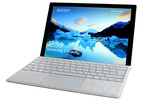Microsoft Surface Pro (2017) m3
Specifications

Secondary Camera: 8 MPix AF, rear
Price comparison
Average of 1 scores (from 1 reviews)
Reviews for the Microsoft Surface Pro (2017) m3
Affordable Surface! Although it is already the second half of 2017, Microsoft presents the latest Surface based on a frugal Core m3 processor with connectivity that is still in need of reworking. Find out in this review whether the long battery life and the established brand name are enough to win buyers.
Source: Ofertaman
 ES→EN Archive.org version
ES→EN Archive.org versionPositive: Nice display; elegant design; silent system; support Mini DisplayPort; high autonomy. Negative: No accessories; only 4GB RAM and 128GB SSD; only USB type A.
Single Review, online available, Very Short, Date: 05/15/2019
Comment
Series:
Microsoft Surface Pro (2017) is the fifth generation in the Surface Pro family. The Surface Pro is solid as a rock and exudes a sense of futuristic quality. It’s also well-designed, with a look and feels that, while minimally changed from the Surface Pro 4, is still an improvement. The corners are more rounded, and the exhaust vents along the edges are less pronounced. There aren’t many moving parts in the Surface Pro itself. The power and volume buttons along the top are easy to find by feel, and have a crisp action, while the kickstand is smooth and reliably holds the tablet at chosen angle. It now opens up to 165 degrees, an increase from the Surface Pro 4, which opened 150 degrees. Fully flexed, the kickstand can turn Surface Pro into a nearly-flat slate. If a user decides to flip into tablet mode for a moment and fold back the Type Cover, the keyboard will turn off when the cover is tucked back. It can even switch Windows 10 into tablet mode if desired. It attaches to the tablet with strong magnets and connects via a physical port, meaning there’s zero lag when typing. The Surface Pro sports two front-firing speakers on each side of the display. There are small cutouts in the glass to let the sound through, and the design provides impressive sound for a tablet. Music is great, with surprising range, and there’s even a hint of bass. The speakers also get surprisingly loud and can fill a decent sized room without distorting.
The Surface Pro features up to a seventh-generation Intel Core i7, 16GB of RAM, and a 1TB SSD. It is seen that the Surface Pro offers a cutting-edge CPU, solid RAM and SSD options, and full support for all of Microsoft’s most innovative Windows 10 technologies. All that will keep the machine relevant for years to come. The Surface Pro is refreshingly light on bloatware. While it’s stocked with the usual Microsoft Windows 10 apps and a handful of casual games, it’s otherwise unencumbered with junk software. The Surface utility is also a nice app that offers the ability to configure the Surface Pen and get some useful information about your machine. Microsoft is using a 45-watt-hour battery in the Surface Pro, which is an increase from the 38 watt-hour battery that was packed into the Surface Pro 4. The Surface Pro also uses more efficient seventh-generation Intel Core processors. Taken together, the new model offers improved battery life over its predecessor. The Surface Pro is eminently portable, at 0.33 inches thick and 1.73 pounds. Even with the Signature Type Cover attached, the machine is easy to carry around and slip into a bag. It might not be quite as thin and light as the iPad Pro, but it’s also a much more powerful machine that can run real PC applications. The Surface Pro bring a whole new meaning to the word tablet. It is a iPad like device but is actually a real computer.
Hands-on article by Jagadisa Rajarathnam
Intel HD Graphics 615: Integrated graphics card in some Kaby Lake Y-series processors (4.5 Watt TDP) with 24 EUs (GT2) and no dedicated graphics memory. Clocks with Update to 1050 MHz depending on the CPU Model.
Non demanding games should be playable with these graphics cards.
» Further information can be found in our Comparison of Mobile Graphics Cards and the corresponding Benchmark List.
m3-7Y30: Extremely efficient ULV-SoC (System-on-a-Chip) for tablets and fanless notebooks based on the Kaby Lake architecture. Includes two CPU cores clocked at 1.0-2.6 GHz with Hyper Threading support as well as a graphics adapter and is manufactured in a 14 nm process.» Further information can be found in our Comparison of Mobile Processsors.











